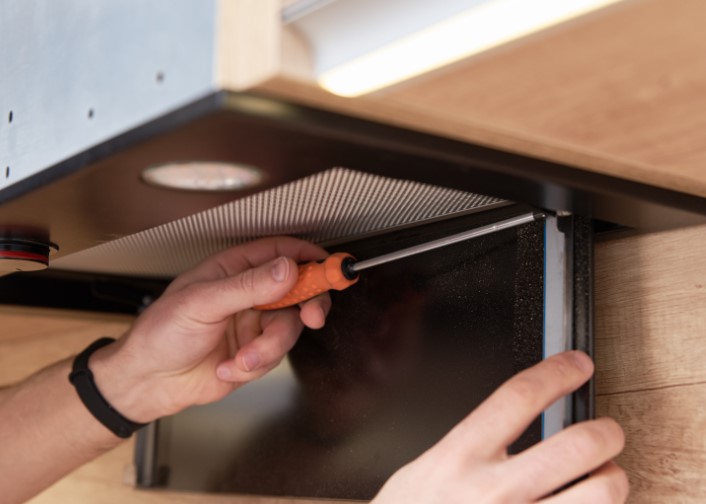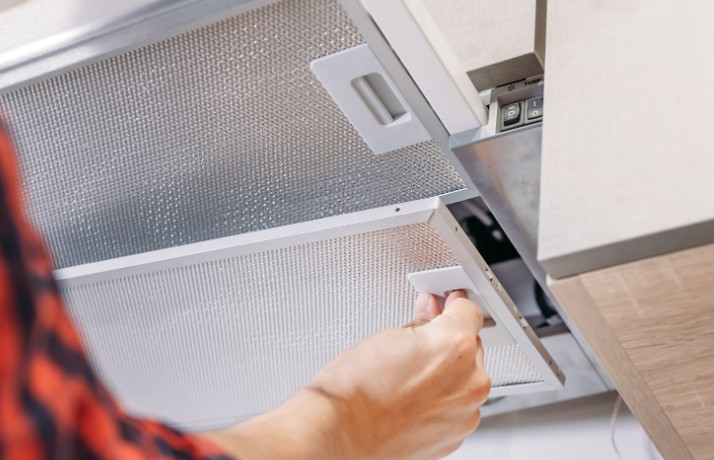- Why Should I Clean My Cooker Hood Filter Regularly?
- What Tools and Ingredients Do I Need?
- Are Cooker Hood Filters Washable?
- How to Clean a Metal Mesh Cooker Hood Filter?
- How to Clean Cooker Hood Filter? 5 Natural Smart DIY Ideas
- What Type of Filter Do I Have and Does It Matter?
- Pro Tips for Long-Term Cooker Hood Maintenance
- Summary Table: 5 DIY Methods Compared
- Conclusion: Keep It Clean, Keep It Natural
- FAQs on How To Clean Cooker Hood Filter
Need tips on how to clean cooker hood filter? Cleaning a cooker hood filter may not top anyone’s to-do list, but it’s essential for maintaining a clean and healthy kitchen.
I’ve learned that with a few smart, natural methods, tackling that sticky, greasy mess can be easier—and more satisfying—than you’d think.
Let me walk you through how I do it using simple ingredients and easy-to-follow steps.
Why Should I Clean My Cooker Hood Filter Regularly?
You might wonder, why do you have to clean kitchen hood filters at all?
Over time, filters collect grease, smoke, and food particles that reduce airflow and make your extractor fan work harder.
If ignored, the grime can affect your indoor air quality and even pose a fire risk.
From my experience, cleaning your cooker hood filter every couple of weeks—or monthly, depending on how often you cook—helps your kitchen stay fresh, your appliance run smoothly, and your bills stay lower.

What Tools and Ingredients Do I Need?
The best part? You don’t need harsh chemicals.
I stick with natural effective ingredients you probably already have in your kitchen, like baking soda, white vinegar, lemon juice, and dish soap.
I also keep an old toothbrush handy for scrubbing, and a deep basin or sink to soak the filter in hot water.
These eco-friendly options work well on metal mesh and stainless steel filters, without damaging them.
Are Cooker Hood Filters Washable?
Yes—metal mesh filters, which are common in UK homes, are washable and designed for long-term use.
Just be careful with carbon or charcoal filters; those aren’t washable and should be replaced every few months instead.
If you’re unsure whether your filter is reusable, check the manufacturer’s guide or look for visible wear.
If it’s warped, crumbling, or permanently discoloured, it’s time for a replacement.
How to Clean a Metal Mesh Cooker Hood Filter?
Metal mesh filters are durable but prone to grease buildup as in kitchen cupboards.
To clean them, I usually start by removing the filter and soaking it in a mix of hot water, baking soda, and white vinegar for about 20 minutes.
After that, a gentle scrub with a brush lifts off the residue. It’s important to rinse thoroughly and let it dry before placing it back.
Avoid using bleach or abrasive pads, especially on aluminium filters, which can scratch or corrode easily.

How to Clean Cooker Hood Filter? 5 Natural Smart DIY Ideas
What is the best way to clean range hood filters?
In my opinion, the baking soda and boiling water combo gives the best results.
But here are five natural, DIY methods I use based on how messy the filter is.
1. Baking Soda and Boiling Water
This is my go-to for heavy grease.
I fill a sink with boiling water, add a few tablespoons of baking soda, and let the filter soak. After 15–20 minutes, most of the grime wipes right off.
2. White Vinegar Soak
If I’m dealing with a stainless steel filter, I prefer a vinegar soak.
I add a cup or two of white vinegar to hot water and leave the filter in for 30 minutes. The vinegar naturally cuts through the grease without damaging the finish.
3. Lemon Juice Steam Cleaning
This method is best when I’m short on time.
I boil lemon slices in a pan of water under the hood and let the steam work its way through the filter. It’s not a deep clean, but it freshens things up nicely.
4. Eco Dish Soap and Hot Water
Sometimes, a good soak in hot water and eco-friendly dish soap does the trick.
I let it sit for about 20 minutes, then gently scrub with a brush to lift off the softened grease.
5. DIY Degreaser Spray
For quick upkeep, I make a spray using white vinegar, lemon juice, and a bit of essential oil.
A few spritzes after cooking and a quick wipe-down help prevent buildup in the first place.
What Type of Filter Do I Have and Does It Matter?
Knowing your filter type makes a difference.
Aluminium mesh filters are washable and need regular cleaning, while carbon or charcoal filters trap odours and need to be replaced every 3–6 months.
It’s also worth noting that stainless steel filters can handle stronger cleaning solutions than aluminium ones, which are more sensitive to acidic or abrasive products.

Pro Tips for Long-Term Cooker Hood Maintenance
Keeping your filter clean is only part of the job. I also make sure to cook with lids on pots to reduce splatter and wipe down the hood regularly.
If you start seeing grease accumulate again soon after cleaning, you might want to clean more frequently or consider replacing an old filter.
Summary Table: 5 DIY Methods Compared
| Method | Best For | Ingredients | Soak Time | b Needed |
| Baking Soda & Water | Heavy grease | Baking soda, boiling water | 15–20 min | Yes |
| Vinegar Soak | Stainless steel | White vinegar, hot waterScru | 30 min | Optional |
| Lemon Steam | Quick freshening | Lemon slices, water | 10 min | No |
| Dish Soap & Hot Water | General cleaning | Dish soap, hot water | 20 min | Yes |
| Degreaser Spray (DIY) | Regular upkeep | Vinegar, lemon juice | N/A | No |
Conclusion: Keep It Clean, Keep It Natural
A clean cooker hood filter means better air, better performance, and a better kitchen experience.
Whether it’s a quick lemon steam or a deep baking soda soak, there’s a method that fits your time and needs.
By choosing natural cleaners and regular upkeep, I’ve saved money, protected my appliance, and kept my home healthier. It is simple, satisfying & well worth the effort.
Related Article: How To Use a Brita Water Filter?
FAQs on How To Clean Cooker Hood Filter
1. Can I put my cooker hood filter in the dishwasher?
Yes, if it’s a metal mesh filter. Just avoid using high heat or harsh detergents, and don’t use the drying cycle of the dishwasher.
2. How do I know it’s clean enough?
I hold it up to the light—if I can see through it clearly, it’s clean.
3. Can I use bleach?
I don’t recommend it. Bleach can damage the filter material and leave behind harmful fumes.


0 Comments